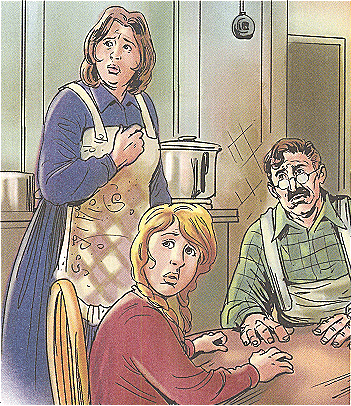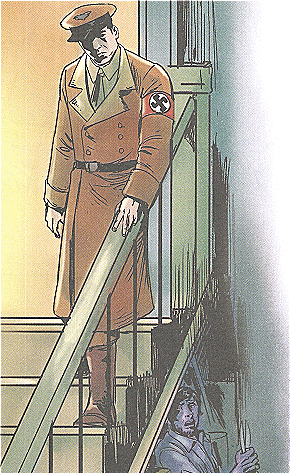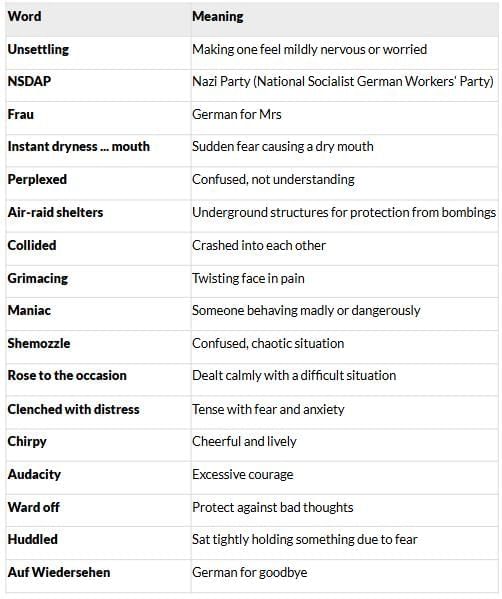The Visitor Chapter Notes | Gul Mohar Class 8: Book Solutions, Summaries & Worksheets PDF Download
| Table of contents |

|
| About the Author |

|
| Key Points |

|
| Detailed Summary |

|
| Theme |

|
| Message |

|
| Vocabulary |

|
About the Author
Markus Zusak, an Australian writer, is best known for his international bestsellers The Book Thief and The Messenger. His novels, often for young adults, explore themes of courage, morality, and human resilience. The Visitor, an excerpt from The Book Thief, is set during World War II in Nazi Germany, showcasing the bravery of ordinary people against oppressive regimes.
Key Points
- Liesel Meminger, a twelve-year-old German girl, learns that Nazi officials are inspecting basements on Himmel Street to assess their suitability as air-raid shelters.
- The Hubermann family—Liesel, Hans, and Rosa—are hiding Max Vandenburg, a Jewish man, in their basement, risking death if discovered.
- Liesel, playing football, stages a collision to justify returning home, alerting her parents about the inspection.
- Hans calmly orchestrates a plan to act normal, instructing Rosa and Liesel to behave casually during the Nazi inspection.
- The Nazi official inspects the basement, unaware of Max hiding beneath the stairs, and deems it too shallow for a shelter.
- The family survives the tense inspection, and Max, safe but guilt-ridden, apologizes for endangering them.
Detailed Summary
In The Visitor, an excerpt from The Book Thief by Markus Zusak, set in Nazi Germany during World War II, twelve-year-old Liesel Meminger faces a crisis while playing football on Himmel Street. The Hubermann family—Liesel, her foster father Hans, and mother Rosa—are secretly hiding Max Vandenburg, a Jewish man, in their basement, an act punishable by death under Hitler’s regime. While playing, Liesel learns from her friend Rudy that Nazi officials are inspecting basements to determine their suitability as air-raid shelters. Panic seizes her, as discovery of Max would doom the family. 
Struggling to return home without arousing suspicion, Liesel deliberately collides with another player, Klaus Behrig, during the game, grazing her knee. A kindly Nazi official, witnessing the incident, helps her up and asks where she lives. Liesel insists she’s fine, but Rudy, stubbornly, offers to escort her home. To delay and involve Hans, Liesel pretends further injury, asking Rudy to fetch her Papa. Hans arrives, calmly assessing the situation as the Nazi official nears their house. Inside, Liesel whispers the alarming news about the basement checks. With no time to move Max, Hans decides they must act as if they have “not a care in the world.” As the Nazi knocks, Hans warns Max, hiding under the basement stairs, while instructing Rosa and Liesel to remain composed.
 Rosa, clenched with distress, opens the door, and the cheerful official, recognizing Liesel as the “maniacal football player,” inspects the basement. Hans tends to Liesel’s knee, masking his fear as concern, while Rosa snaps about teaching Liesel a lesson. The official, hearing measuring tape sounds from the basement, declares it too shallow for a shelter. Liesel, sent to fetch a book, nearly collides with the official but maintains her composure. After he leaves, the family retrieves Max, who, soaked in sweat and clutching rusty scissors, apologizes for the danger. Rosa reassures him, “You’re alive. We all are,” affirming their survival through quick thinking and bravery.
Rosa, clenched with distress, opens the door, and the cheerful official, recognizing Liesel as the “maniacal football player,” inspects the basement. Hans tends to Liesel’s knee, masking his fear as concern, while Rosa snaps about teaching Liesel a lesson. The official, hearing measuring tape sounds from the basement, declares it too shallow for a shelter. Liesel, sent to fetch a book, nearly collides with the official but maintains her composure. After he leaves, the family retrieves Max, who, soaked in sweat and clutching rusty scissors, apologizes for the danger. Rosa reassures him, “You’re alive. We all are,” affirming their survival through quick thinking and bravery.
Theme
The story explores courage, moral resistance, and the tension of living under oppression. It highlights the bravery required to protect others in the face of extreme danger and the strength found in family unity during crises.
Message
The message is that standing up for others, even at great personal risk, reflects profound courage and humanity. Zusak emphasizes that quick, thoughtful decisions in crises, grounded in compassion and resilience, can overcome fear and preserve hope in dark times.
Vocabulary

|
32 videos|62 docs|17 tests
|
FAQs on The Visitor Chapter Notes - Gul Mohar Class 8: Book Solutions, Summaries & Worksheets
| 1. What is the main theme of "The Visitor"? |  |
| 2. Who are the central characters in "The Visitor"? |  |
| 3. What message does "The Visitor" convey about cultural differences? |  |
| 4. How does the author use symbolism in "The Visitor"? |  |
| 5. What vocabulary is significant to understanding "The Visitor"? |  |















